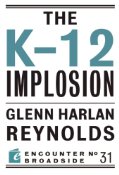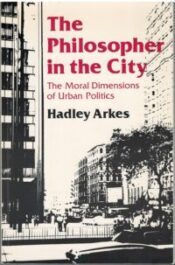
The K-12 Implosion by Glenn Harlan Reynolds
 This book was is one of a series of short “broadsides” published by Encounter Books. It is the first that this reviewer has read, but undoubtedly will not be the last. It is called a “broadside” presumably because it hearkens back to an earlier time in American history when serious debate was waged through the publication of pamphlets explaining the positions of different sides of a question. One could argue that the Federalist and Anti-Federalist Papers were part of this proud tradition.
This book was is one of a series of short “broadsides” published by Encounter Books. It is the first that this reviewer has read, but undoubtedly will not be the last. It is called a “broadside” presumably because it hearkens back to an earlier time in American history when serious debate was waged through the publication of pamphlets explaining the positions of different sides of a question. One could argue that the Federalist and Anti-Federalist Papers were part of this proud tradition.
Today, there is sadly little room in most newspapers for this kind of expository writing. It’s hard to imagine something as weighty as Madison’s Federalist No. 10 being published in the comic-book like sheets of the USA Today. For all their pretensions, the NYT or the WSJ aren’t much better. However, even granting that the Gray Lady and The Journal occasionally feature some intellectual content. Well-reasoned, serious arguments don’t find widespread readership. The Federalist was widely printed and discussed. Tom Paine’s Common Sense and Crisis Papers were as well.
This is not to say that the “broadsides” being published by Encounter Books are hugely intellectual (at least judging by this one). However, the apparent aim is to “arm” thoughtful people with some facts about the important issues of today. (Perhaps that’s another reason for their being called “broadsides.”)
The K-12 Implosion deals with the problem of an increasingly expensive and poorly performing American educational system. It is a brief collation of facts and analysis about the state of American Education.  It is only 38 pages of clear prose, written in large type. The K-12 implosion doesn’t necessarily provide answers to the problems facing the nation’s schools, but does document why things are the way they are and offers a range of ideas which will undoubtedly be tried to resolve the issues.
Reynolds makes it clear that there is no one-size-fits-all answer, and indeed asserts that trying to force American students into such a system is a big reason why American education is in such dismal shape.
Reynolds quotes entrepreneur and thinker Seth Godin:
Large scale education was not developed to motivate kids or to create scholars. It was invented to churn out adults who worked well within the system. Scale was more important than quality, just as it was for most industrialists.
Of course it worked. Several generations of productive, fully employed workers followed. What now?
….
Every year, we churn out millions of workers who are trained to do 1925-style labor.
It is an interesting premise. Whether it is true or not, one thing is undeniable, the current system is no longer working. In fact it’s getting worse faster. And money is not the issue. It seems the more we spend, the worse it gets.  Outmoded methods are not the only reason that Reynolds cites. There is plenty of blame to go around. The educational establishment certainly deserves its share of the credit for the mess things are in.
… Today’s schools, however, aren’t even successfully teaching the basics.
What’s more, as we’ve increased the amount of money going in, there’s been no corresponding increase in learning. One reason for that is that a disproportionate amount of money has gone into administration, rather than to teaching. According to a report in The Education Gadfly describing a study by Benjamin Scafidi called The School Staffing Surge: Decades of Employment Growth in America’s Public Schools, “between 1950 and 2009, the number of K-12 public school students increased by 96%. During that same period, the number of full-time equivalent (FTE) school employees grew by 386%. Of those personnel, the number of teachers increased by 252%, while the ranks of administrators and other staff grew by 702%–more than seven times the increase in students.”
These education administrators don’t teach; if anything, they create paperwork for the people who do. Some of them, of course, are required to by federal regulations, but that hardly improves the situation on the ground. There is one reason more money hasn’t improved things: it’s not going to teaching but to paper pushing. As Robert Barranco and Michael McShane write, “in constant dollars, education spending rose from $1214 in 1945 to just under $10,500 in 2008. The St. Louis Public schools, for example, spend more than $14,000 per student per year, so if it has problems, money is not one of them.
And what better personifies the educational establishment than the teacher’s unions?
Adding teachers and administrators has benefited unions (more members) and politicians who draw support from those unions (more voters beholden to them), and it costs a lot of money. What it hasn’t done is conferred any measurable benefit on students, who are supposed to be the beneficiaries of public education. And now people have started to notice.
The result is that parents and taxpayers are losing faith in public education. And that portends a potential implosion.
And with this sentence Reynolds begins his explanation of yet another cause of the decline in American Education. The more disgusted and disheartened people become with an abysmal system, the more they seek alternatives. The more they seek alternatives, the less children there are to enroll in public schools. And since parents who give a damn tend to be self-selecting, what’s left for the public schools is disproportionately skewed to lower performing students of parents who either don’t know, don’t care, don’t have a choice because of their economic circumstances, or who simply view school as state-funded day care.
Parents are leaving the school districts because they want better educations for their children. But the consequences for the districts can be devastating.
First, the students who are leaving are probably better than average because their parents care so much about their educations. That means that when they leave, the overall quality of the remaining students, and thus the schools, will drop.
Second, funding is often based on the number of pupils in schools, so when the students leave, the schools have less money. Since it’s hard to get rid of teachers, they probably cut “plus” programs like music, art, etc.–But losing those will make the schools less appealing to students who are thinking of leaving, probably accelerating the trend.
Third, parents–that is, taxpayers–who are sending their kids elsewhere (especially those who are homeschooling or sending their kids to private or online schools) will probably be less willing to support taxes for the benefit of public schools they are not using and probably don’t think highly of. And, for that matter, once public schools are no longer seen as a near universal institution, taxpayer support in general is likely to fall off. That, of course, means schools will be less funded, which will probably encourage still more students to depart and cause more parents to resent paying taxes for public schools their kids don’t use, in a vicious circle that produces shrinkage year after year.
Options
After chronicling (and supporting with facts) these and other causes for the decline in American education, Reynolds offers some hope for the future. He argues that the current system is not only bad, it’s unsustainable — it’s simply too expensive to continue. There will be a change whether the education establishment wants it or not. Reynolds quotes economist Herbert Stein who famously said, “Something that can’t go on forever, won’t.”
Reynolds admits that there is no single or perfect solution, and indeed advocates for a variety of different approaches, tailored to the specific needs of the student. The one he focuses on most is online study (for the student capable, and disciplined enough to take advantage of it.) Reynolds uses the example of his own daughter who was able to get a jump start on college, quit wasting time in a high-school with a curriculum far beneath her capabilities, and gain valuable work experience to boot. Reynolds admits that this won’t work for everyone, but can work for some.  He is a big advocate for exploiting advances in educational technology in use by organizations like the online Khan Academy.
Is. online school for everyone? Absolutely not. Some kids don’t have the discipline to sit down at a computer every day and do school work with no one looking over their shoulder .… But for the right kids, the online approach offers benefits the traditional school doesn’t.
Some children benefit from a Montessori approach that allows kids to follow their own interests and work at their own pace. Other kids benefit from a more rigidly structured traditional approach. Still others do best with homeschooling, which seems to be enormously beneficial for many kids when their parents are willing and able to invest in the effort. (Look at how many home schoolers win the National Spelling Bee).
Although the end of the broadside reads a little like an advertisement for the Khan Academy, it’s hard to fault Reynold’s thinking. Overall, he doesn’t focus much on the reasons for decline in American Education, other than to provide a few obvious ones. (He doesn’t get into the core of liberal thinking and the inculcation of Progressive agendas in textbooks and teacher education.) Instead, in a limited amount of space, he tries to get people thinking about reasonable alternatives and to realize that maybe there are viable solutions.
 The posts are coming!
The posts are coming!

3 comments
How much genius, effort, and expense does it take to survey the few (100’s) of schools that are teaching the fundamentals of the three R’s excellently and determine what works — i.e., that the excellent teaching is confirmed by the students’ excellent learning?
Following that survey, correlate: teacher training, methods of instruction, teaching materials, student IQ, social/family factors, with students’ results.
Adaptation of these correlations to less-well performing schools so as to tease out cause-and-effect relations to further improve the interaction of pertinent factors for better learning, would be a next step in a continuing cycle of improvements.
If this is thought to be too expensive and/or time consuming assign the effort to each state’s universities’ departments of education and mathematics as theses subjects, NOW!
Let’s raise competent, civic-minded citizens instead of education-deprived puppets and dummies.
A citizen-parent supported effort ought to be possible as well — including textbook approvals, county-by-county, so as to take the selection of teaching materials out of the hands incompetent and corrupt administrators. They know who they are.
Of course, some funding for education is available by cutting out school administration bloated fat.
[Reply]
Martin Reply:
August 10th, 2014 at 3:40 pm
Thanks for your thoughts. I don’t know that commonsense has much to do with it. It’s more about furthering agendas than teaching kids.
[Reply]
Howard Nelson Reply:
August 14th, 2014 at 3:53 pm
Yes. The fault dear Brutus is not in our masters, but that so much that should bother us a lot hardly bothers us at all.
[Reply]
Leave a Comment